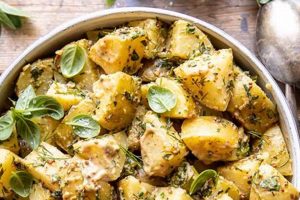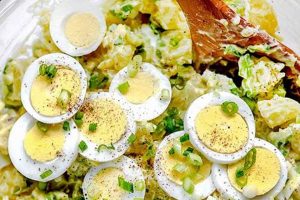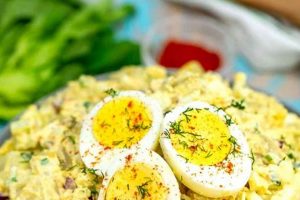This dish typically consists of cooked, cubed russet potatoes combined with mayonnaise, mustard, and other ingredients such as celery, onion, and hard-boiled eggs. Variations can include different herbs, spices, and additions like pickles or relish. A classic example features tender potatoes coated in a creamy dressing, punctuated by the richness of egg and the crunch of fresh vegetables.
The selection of russet potatoes offers specific advantages. Their high starch content contributes to a fluffy texture when cooked, allowing them to absorb flavors from the dressing while maintaining their shape. The inclusion of eggs adds a protein boost and contributes to the creamy consistency. This versatile side dish can be served at picnics, barbecues, potlucks, and holiday gatherings, offering a satisfying and familiar comfort food experience. Its enduring popularity stems from its simple preparation, customizable nature, and readily available ingredients.
The following sections will explore optimal methods for preparing this dish, addressing key aspects such as potato selection and cooking techniques, achieving the perfect dressing consistency, and creative variations to enhance flavor profiles.
Tips for a Perfect Potato Salad
Achieving optimal results requires attention to detail throughout the preparation process. The following tips offer guidance for creating a delicious and visually appealing potato salad.
Tip 1: Uniform Potato Size: Consistent potato size ensures even cooking. Aim for roughly one-inch cubes to achieve optimal texture and prevent some pieces from becoming overcooked while others remain undercooked.
Tip 2: Proper Cooking Technique: Avoid overboiling the potatoes, as this can result in a mushy texture. Cook until tender but still firm enough to hold their shape. Start with cold water, add salt, and bring to a boil. Drain immediately upon reaching the desired tenderness.
Tip 3: Cooling the Potatoes: Allow the cooked potatoes to cool completely before adding the dressing. This prevents the dressing from thinning and ensures a creamy, non-watery consistency.
Tip 4: Dressing Consistency: A balanced dressing is key. Achieve the desired creaminess by gradually adding the mayonnaise and other ingredients, ensuring thorough coating and avoiding over-dressing.
Tip 5: Enhancing Flavor: Elevate the flavor profile with fresh herbs such as dill or chives, spices like paprika or celery seed, and additions like chopped pickles or sweet relish.
Tip 6: Egg Preparation: Perfectly cooked hard-boiled eggs are essential. Avoid overcooking, which can cause the yolks to become dry and discolored. Cool the eggs immediately after cooking to prevent a greenish ring from forming around the yolk.
Tip 7: Chilling and Serving: Allow the potato salad to chill thoroughly in the refrigerator for at least an hour before serving. This allows the flavors to meld and enhances the overall taste experience.
By following these guidelines, one can create a potato salad that showcases the ideal balance of textures and flavors, delivering a truly satisfying culinary experience.
These tips contribute to a final product that is not only visually appealing but also delivers on flavor and texture. The subsequent section will offer concluding thoughts and variations on this classic dish.
1. Russet Potatoes
Russet potatoes play a crucial role in the success of a russet potato salad recipe that includes eggs. Their unique characteristics contribute significantly to the dish’s overall texture and flavor profile. The high starch content of russet potatoes lends itself well to boiling, resulting in a light and fluffy interior that readily absorbs the dressing’s flavors. This contrasts with waxy potato varieties, which tend to hold their shape more firmly and may result in a denser, less absorbent final product. Consider the difference between a classic potato salad made with russets and one made with red potatoes: the former will offer a creamy, melt-in-your-mouth experience, while the latter retains a firmer bite and less dressing absorption.
This absorbency is key to a well-balanced potato salad. The fluffy potato pieces soak up the dressing, ensuring every bite is flavorful and cohesive. Moreover, the neutral flavor of russets allows the other ingredients, such as the eggs, celery, onion, and seasonings, to shine. Imagine a potato salad made with a strongly flavored potato varietythe delicate balance of flavors would be disrupted, and the overall experience diminished. Choosing russets ensures the potato acts as a canvas for the other components, contributing texture and subtle flavor without overpowering the overall composition.
In summary, the selection of russet potatoes is a deliberate choice based on their specific properties. Their high starch content, resulting in a fluffy texture and excellent absorbency, contributes significantly to a successful potato salad. This understanding underscores the importance of ingredient selection in achieving desired culinary outcomes and highlights the practical significance of choosing the right potato for the job. While other potato varieties can be used, none quite replicate the classic texture and flavor profile achieved with russets, demonstrating their unique suitability for this application.
2. Hard-boiled Eggs
Hard-boiled eggs constitute an essential component of a classic russet potato salad. Their inclusion contributes not only nutritional value but also distinct textural and flavor elements that enhance the overall culinary experience. The protein provided by eggs complements the carbohydrates from the potatoes, offering a more balanced nutritional profile. Furthermore, the creamy yolk, when properly cooked, adds a richness that contrasts with the tangy dressing and the starchy potatoes, creating a more complex flavor dynamic. Consider the difference between a potato salad with and without eggs: the former offers a depth of flavor and textural variation often lacking in the latter.
The preparation of the hard-boiled eggs significantly impacts the final result. Overcooking leads to dry, crumbly yolks and a rubbery texture, detracting from the desired creaminess. Conversely, undercooking results in a runny yolk that can create an undesirable texture and make the salad difficult to serve. Achieving the perfect hard-boiled egg, with a firm yet creamy yolk, requires precise timing and immediate cooling. This attention to detail elevates the potato salad from a simple side dish to a carefully constructed culinary creation. Imagine the textural contrast between a perfectly cooked, firm egg white and a creamy yolk against the soft potatoes and the tangy dressing this interplay of textures contributes significantly to the enjoyment of the dish. Practical applications of this understanding include adjusting cooking times based on egg size and altitude and employing rapid cooling techniques to prevent overcooking. These seemingly small adjustments profoundly impact the final product.
In summary, the inclusion of hard-boiled eggs in a russet potato salad recipe serves a multifaceted purpose. Beyond their nutritional contribution, they provide essential textural and flavor elements that elevate the overall dish. The method of preparation directly influences these contributions, underscoring the importance of proper cooking techniques in achieving desired outcomes. Mastery of this element contributes to a more satisfying and complete culinary experience, highlighting the interconnectedness of ingredients and techniques in achieving a well-balanced and flavorful dish. This attention to detail distinguishes a truly exceptional potato salad from a mediocre one.
3. Mayonnaise-based dressing
Mayonnaise-based dressing forms the foundational sauce element, binding the ingredients and imparting a characteristic creamy texture and tangy flavor to russet potato salad with egg. This dressing serves as a critical bridge, uniting the individual componentspotatoes, eggs, and other additionsinto a cohesive whole. The emulsion of oil and egg yolks in mayonnaise provides a rich, smooth coating that adheres to the potatoes, ensuring even distribution of flavor and preventing the salad from becoming dry. This cohesive quality distinguishes potato salad from a mere mixture of chopped ingredients; it transforms them into a unified dish. Consider the contrast between a potato salad tossed in a light vinaigrette and one enveloped in a creamy mayonnaise dressing: the latter exhibits a distinct richness and textural harmony absent in the former. This fundamental difference underscores the mayonnaise-based dressing’s essential role. Without it, the individual flavors remain isolated, lacking the characteristic creaminess and tang that define this classic dish.
The specific composition of the mayonnaise-based dressing allows for considerable variation and customization. While classic recipes often incorporate mustard, vinegar, and seasonings like celery seed or paprika, adaptations can include fresh herbs, spices, or even additions like chopped pickles or relish. This adaptability provides opportunities to tailor the flavor profile to individual preferences while maintaining the fundamental creamy texture and tangy base provided by the mayonnaise. For instance, a Dijon mustard-based dressing imparts a sharper, more robust flavor compared to a dressing featuring yellow mustard. Similarly, the addition of fresh dill introduces a bright, herbaceous note, while a sprinkle of paprika offers a subtle smokiness. These variations, while diverse, all rely on the mayonnaise base to provide the essential creamy texture that binds the ingredients and carries the complementary flavors.
In conclusion, the significance of mayonnaise-based dressing in a russet potato salad with egg recipe extends beyond merely holding the ingredients together. It provides a critical textural elementcreaminessand a foundational flavor profiletanginessthat define the dish. Furthermore, its adaptable nature allows for customization and exploration of diverse flavor combinations, all while maintaining the essential characteristics that make this a beloved classic. An understanding of the dressing’s role highlights the importance of balancing flavors and textures to achieve a well-rounded and satisfying culinary experience. Successfully executing this balance results in a potato salad that transcends a simple side dish, becoming a culinary creation in its own right.
4. Complementary Ingredients
Complementary ingredients play a crucial role in elevating russet potato salad with egg beyond a simple combination of its core components. These additions contribute layers of flavor, texture, and visual appeal, transforming the dish into a more complex and satisfying culinary experience. Consider the foundational elements: potatoes and eggs offer relatively neutral flavor profiles and soft textures. Complementary ingredients introduce contrasting flavors, such as the sharp tang of mustard, the pungent bite of onion, or the crisp freshness of celery. Textural contrasts also emerge through these additions; crunchy celery and onion offer a counterpoint to the soft potatoes and eggs, while finely chopped pickles or relish introduce a pleasant acidity and subtle chewiness. These contrasts prevent textural monotony and elevate the overall sensory experience.
Specific examples illustrate the transformative impact of complementary ingredients. The addition of finely diced red onion introduces not only a pungent bite but also a vibrant pop of color, enhancing the visual appeal. Chopped celery contributes a refreshing crunch and subtly herbaceous flavor, balancing the richness of the mayonnaise and eggs. A sprinkle of paprika adds a touch of smokiness and warm color, while fresh dill or chives provide a bright, herbaceous counterpoint to the creamy dressing. The strategic use of these ingredients elevates the potato salad from a basic dish to a multi-dimensional culinary creation. Imagine a potato salad without these additions: the flavor profile would be bland, the texture monotonous, and the visual presentation lackluster. The inclusion of carefully selected complementary ingredients elevates the dish to a new level of complexity and enjoyment. Practical applications include balancing the ratios of these ingredients to achieve desired flavor profiles, experimenting with different combinations to cater to individual preferences, and considering the overall visual impact of the chosen additions.
In summary, complementary ingredients are not mere afterthoughts in a russet potato salad with egg recipe. They function as essential components that contribute significantly to the overall flavor, texture, and visual appeal. Understanding the role and impact of these additions allows for strategic selection and incorporation, ultimately transforming a simple dish into a well-balanced and satisfying culinary experience. The careful consideration of these elements differentiates a truly exceptional potato salad from a basic one, demonstrating the profound impact of seemingly minor additions. This understanding extends beyond the specific recipe, highlighting the importance of complementary ingredients in culinary creations across a broad spectrum.
5. Proper Cooking Techniques
Proper cooking techniques are essential for achieving a successful russet potato salad with egg. These techniques directly influence the final texture and flavor of the dish, impacting the overall culinary experience. Consider the effect of boiling the potatoes: overcooking results in mushy, waterlogged potatoes that fail to hold their shape and absorb the dressing effectively, while undercooking leads to firm, unyielding potatoes that detract from the desired creamy texture. This cause-and-effect relationship underscores the importance of precise cooking times and attentive monitoring. For example, starting the potatoes in cold, salted water and bringing them to a boil ensures even cooking throughout. Draining the potatoes immediately upon reaching the desired tenderness prevents further cooking and helps maintain their structural integrity, a crucial factor in achieving the perfect texture. This meticulous approach distinguishes a well-executed potato salad from a subpar one.
Beyond the potatoes, proper cooking techniques extend to the eggs. Overcooked eggs develop dry, crumbly yolks and rubbery whites, diminishing their contribution to the salad’s overall creaminess and flavor. Undercooked eggs, on the other hand, present a runny yolk that can create an undesirable texture and make the salad difficult to handle. Achieving the ideal hard-boiled eggfirm whites and creamy yolksrequires precise timing and immediate cooling upon completion. For instance, plunging the cooked eggs into an ice bath halts the cooking process and helps prevent the formation of a greenish ring around the yolk, a common indicator of overcooking. These seemingly minor details contribute significantly to the overall quality and enjoyment of the dish. Practical applications of this understanding include adjusting cooking times based on egg size and altitude and employing appropriate cooling methods to ensure optimal results.
In summary, proper cooking techniques are integral to a successful russet potato salad with egg recipe. They directly impact the texture and flavor of both the potatoes and eggs, influencing the overall quality and enjoyment of the dish. Mastery of these techniquesfrom boiling the potatoes to perfectly cooking the eggsdemonstrates a commitment to culinary excellence and results in a final product that transcends a simple side dish, becoming a carefully constructed and satisfying culinary creation. Challenges may include adapting to variations in stovetop heat or altitude, necessitating adjustments to cooking times. However, the underlying principles remain constant: precise timing, attentive monitoring, and appropriate cooling methods are key to achieving optimal results and elevating the potato salad to its full potential.
Frequently Asked Questions
This section addresses common inquiries regarding russet potato salad with egg, offering practical guidance and clarifying potential points of confusion.
Question 1: Why are russet potatoes preferred for potato salad?
Russet potatoes possess a high starch content, contributing to a fluffy texture ideal for absorbing dressing and maintaining shape after cooking, unlike waxy potatoes which remain firmer.
Question 2: How can one prevent overcooked potatoes in potato salad?
Overcooking can be avoided by starting potatoes in cold salted water, bringing to a boil, and immediately draining upon reaching desired tenderness. Testing for doneness with a fork ensures the potatoes are cooked through but not mushy.
Question 3: What is the optimal method for preparing hard-boiled eggs for potato salad?
Achieving perfectly cooked hard-boiled eggs involves timing and rapid cooling. An ice bath immediately after cooking prevents overcooking and the formation of a greenish ring around the yolk.
Question 4: Can the mayonnaise-based dressing be customized?
The dressing offers versatility. While a classic recipe includes mustard and vinegar, variations can incorporate fresh herbs, spices, or additions like pickles or relish, catering to individual preferences.
Question 5: What are some common complementary ingredients, and what are their benefits?
Common additions include celery for crunch, onion for pungency, and paprika for smokiness. These elements provide textural and flavor contrasts, enhancing the overall sensory experience.
Question 6: How long should potato salad be chilled before serving?
Chilling for at least one hour allows the flavors to meld and enhances the overall taste. Thorough chilling also ensures food safety and optimal serving temperature.
Addressing these frequently asked questions provides a comprehensive understanding of the key elements contributing to a successful russet potato salad with egg. Attention to detail in each step, from ingredient selection to preparation methods, ensures a satisfying culinary outcome.
The following section will offer a complete recipe, incorporating the insights and techniques discussed throughout this article.
Russet Potato Salad Recipe with Egg
This exploration of russet potato salad with egg has delved into the crucial elements that contribute to a successful rendition of this classic dish. From the selection of appropriate potato varieties, emphasizing the textural advantages of russets, to the precise cooking techniques required for both potatoes and eggs, each step plays a vital role in the final outcome. The significance of the mayonnaise-based dressing, acting as both a binding agent and a flavor enhancer, has been highlighted, alongside the transformative impact of complementary ingredients in enriching the sensory experience. Proper cooking techniques, ensuring optimal texture and flavor development, have been underscored as essential for culinary success.
The preparation of russet potato salad with egg represents more than a simple recipe; it embodies a culinary tradition, offering a versatile and adaptable dish suitable for a wide range of occasions. Understanding the nuances of each component and technique allows for informed choices, empowering one to create a potato salad that transcends the ordinary and becomes a personalized culinary expression. This knowledge serves as a foundation for further exploration and experimentation, encouraging adaptation and refinement to suit individual preferences and culinary aspirations. The seemingly simple act of preparing potato salad becomes an opportunity to engage with culinary principles, transforming a familiar dish into a source of both enjoyment and culinary mastery.






